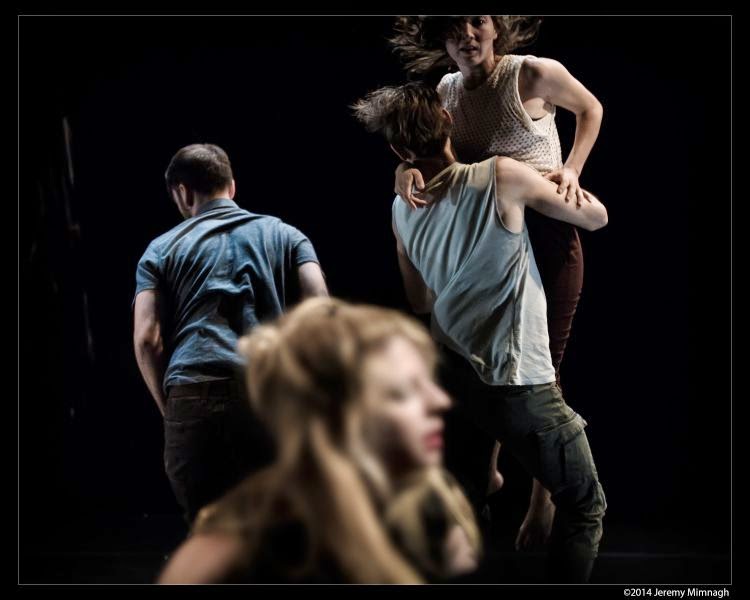elsewhere
a choreographic work by Heidi Strauss
DANCEWORKS
ADELHEID - Production Photos by Jeremy Mimnagh
In the world premiere of Heidi Strauss’s elsewhere, the complex realm of Affect Theory is given
heightened attention as dancers involve themselves in elaborate displays of
individual and group excitability and restraint. Perhaps some of the most
intriguing and enlightening textual moments occur when one of the dancers
stops, mid movement, and attempts to describe what it is like…
The overwhelming ephemeral question, to which there can be
no definitive answer, is pondered in a delicate, somewhat staccato manner by
dancer/performer Molly Johnson as she delivers a series of lines with a kind of
self-assured uncertainty. Her verbal expression becomes a beautiful, fragile,
testimony to the ways in which life and movement intertwine in mysterious,
volatile, at times bewildering ways.
This ménage of varied movement and intermittent verbal
expression is at its best in elsewhere
when it finds specific dance phrasing that allows the dancers to come together
and separate in vivid, at times explosive encounters. The touch of an arm or
the bend of an elbow, in the hands of dancers like Danielle Baskerville, Miriah
Brennan, Luke Garwood, Molly Johnson, and Brendan Wyatt become tightly
conceived, idiosyncratic gestures that are an extreme pleasure to watch.
Music by Jeremy Mimnagh, although evocative and punctuating,
tends to over syncopate some of the rhythms, creating a frequently predictable
sense of mood that overstates otherwise contained and self-evident gestures.
This may be an attempt to illustrate the connected patterns of physical memory
as they manifest themselves through the 'affect' of past corporeal experience.
But it tends to over connect and simplify, when a contrasting, more dissonant
soundscape might deliver more ‘affective’ bodily configurations. Nevertheless,
the music does possess a powerful luminosity as it mixes with the choreography.
Mimnagh’s accompanying light filled, softly flickering projections, displayed
on Duncan Johnstone’s large painted screens, create an effective abstract
counterpart to the shimmering patterns of movement and emotion.
Focused eyes and tense facial expression play a significant
part in the overall balance of physical/emotional lyricism and skeptical
interplay as the ensemble appears acutely aware of their sensory connections to
each other - connections that extend themselves through style and tone among a
series of five deeply committed onstage bodies.
In her programme notes Heidi Strauss explains how affect
theory has influenced elsewhere, and her
perceptions of life and movement in general.
“I now see affect as a part of everyday life, intrinsic to
the reality of any moving body, from the woman walking her dog, to the man
doing Tai-Chi every morning, to the kids kicking the ball in the park across
the street. And these involuntary responses are built on everything we have
experienced until this point - not held in check by the boundaries we might
think we are placing around our own personal histories.”
Desire, appetite, pleasure, pain, and sorrow are basic
tenets of Affect Theory, and, obviously, the experience of being alive in the
world among other bodies. elsewhere, in
many ways, is a simple expression of the complex ways in which bodies respond
to each other over time. Strauss has dared to examine these connections in a
sixty-minute meditation that excites and moves the emotions of the viewer and
the dancer in a pleasurable and powerful manner. And yet there are moments when
the overall choreographic narrative slips and becomes too akin to everyday
experience in a seemingly pointless and random manner. This may very well be an
expression of affect theory. But when it is reduced to a group of dancers
chasing each other across the stage, it becomes superfluous and distracting.
In sharp contrast, when Brendan Wyatt takes part in the
meticulous chaos of flailing arms centre stage, affect becomes explosive and
breathtaking. One witnesses the hit and miss spectacle of a dancer so in
control of the uncontrollable that we sit in awe that he has not knocked his
own head off in the overwhelming process. Or when Wyatt and Luke Garwood embark
upon a beautiful and aggressive pas
de deux, with lifts and anguish in tow, the spectacle is both powerful and
elegant. Or when Molly Johnson, Miriah Brennan, and Danielle Baskerville attend
to their male cohort's aggression, creating delicate and connective gestural
tissues between fingers limbs and torsos, this is where Strauss’s take on
affect theory excels.
Ultimately, affect is dance and dance is movement, and elsewhere
suggests that we are always in another
place - past, present, and future - simultaneously - as we move among each other,
creating the elusive patterns or our breath taking selves. With a slightly more
streamlined (forty five to fifty minutes) take on the overall phrasing of this
one hour piece, whereby music and movement are given less rambling moments of
punctuation and inessential synchronicity, elsewhere could begin to exist more successfully somewhere between theatre and dance. Textual moments could be
expanded and some of the daily, walking rhythms could be excised. The one on
one couplings could be more balanced between genders, rather than a gorgeous
yet somewhat predictable display of masculine and feminine paradigms. This
could enable elsewhere to live everywhere - thereby allowing it to breathe more fully within the
affective modes of patterned uncertainty that human existence and the flesh
filled glory of bodily contortions are inherently prey to.
elsewhere runs at the Harbourfront Centre Theatre until September 27th, 8PM









No comments:
Post a Comment